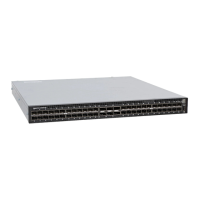Configure VLAN Stacking
Configuring VLAN-Stacking is a three-step process.
1 Creating Access and Trunk Ports
2 Assign access and trunk ports to a VLAN (Creating Access and Trunk Ports).
3 Enabling VLAN-Stacking for a VLAN.
Related Configuration Tasks
• Configuring the Protocol Type Value for the Outer VLAN Tag
• Configuring Dell Networking OS Options for Trunk Ports
• Debugging VLAN Stacking
• VLAN Stacking in Multi-Vendor Networks
Creating Access and Trunk Ports
To create access and trunk ports, use the following commands.
• Access port — a port on the service provider edge that directly connects to the customer. An access
port may belong to only one service provider VLAN.
• Trunk port — a port on a service provider bridge that connects to another service provider bridge and is
a member of multiple service provider VLANs.
Physical ports and port-channels can be access or trunk ports.
1 Assign the role of access port to a Layer 2 port on a provider bridge that is connected to a customer.
INTERFACE mode
vlan-stack access
2 Assign the role of trunk port to a Layer 2 port on a provider bridge that is connected to another provider
bridge.
INTERFACE mode
vlan-stack trunk
3 Assign all access ports and trunk ports to service provider VLANs.
INTERFACE VLAN mode
member
Example of Displaying the VLAN-Stack Configuration for a Switchport
To display the VLAN-Stacking configuration for a switchport, use the show config command from
INTERFACE mode.
Dell#show run interface tengigabitEthernet 1/1
!
interface TenGigabitEthernet 1/1
no ip address
Service Provider Bridging 949

